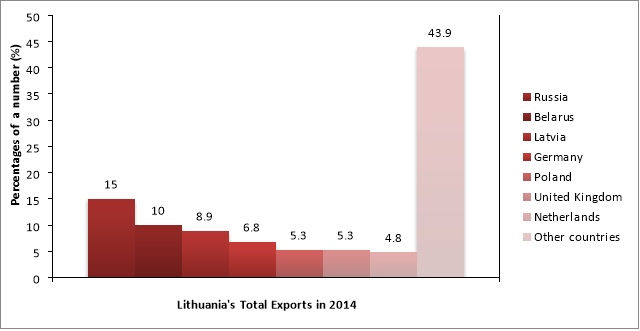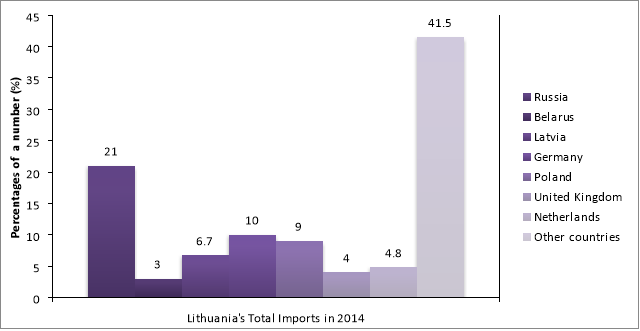Introduction
Trade among countries can be generally clarified as coming from the specialisation of countries in especially industries as moulded by the country’s relative variable endowments. The development of trade specialisation after some time is a phenomenon that frequently reflects profound deep structural changes in the entire monetary system of a nation. After regaining independence in 1990, the reforms essentially changed Lithuania’s economic relations with other countries. Accession to the World Trade organisations signed free trade agreements with many countries, has provided the ability to freely move the capital to and from the country, and Lithuania become from a heavily controlled arranged to a well-functioning market economy when it separated from Soviet Union. And the decisive importance in a small and open country’s economic growth has the foreign trade; especially exports, development. The main reason why is that small economy often do not have enough resources to produce a wide range of goods and services to meet consumer and investment needs inside the country. Therefore, to get the desired imported products, the country corresponding to the foreign markets will have to be able to offer certain goods and services, behind the proceeds to finance the required imports. In this essay, I am going analyse what are Lithuania’s major exports and imports, the challenges that country faces and the major trading partners since the restoration of independence until 2014.
Exports
”Lithuania is the 65th largest export economy in the world and the 33rd most complex economy according to the Economic Complexity Index (ECI).” (Atlas.media.mit.edu, 2017) In 2014, the country has exported around $30.3B which means that the exports increased by $15.4B since 2009. The main reason of this growth is a cross-border proximity trade, the trade between neighbouring countries. As the country has a boarder with Russia, Latvia, Poland and Belarus, the trade between all these nations is being an integral part of the economic development in Lithuania. The graph below shows that in 2014 around 39.2% of all exported goods went to the neighbouring countries. (Atlas.media.mit.edu, 2017)

Table 1: Lithuania’s Total Exports in 2014, atlas.media.mit.edu.
According to Paul Krugman and Maurice Obstfeld ”a country has a comparative advantage in producing a good if the opportunity cost of producing that good in term of other goods is lower in that country than it is in other countries.” (Krugman, Obstfeld and Melitz, 2012) This theory about the work gains from trade was developed by David Ricardo in 1817. As Lithuania belongs to the Baltic States, the trade between Latvia and Estonia is a really important factor for the economic growth. The country has appeal a comparative advantage in a few export categories, e.g. live animals and animal products, vegetable products prepared foodstuffs, products of the chemical industry plastics and articles thereof, wood and articles of wood, textile articles, base metal, vessels like ships boats, furniture, as Lithuania’s opportunity costs of these goods are lower than Latvia’s or Estonia’s opportunity costs.
The country major exports in mineral products as amber, dolomite, cement, clays, limestone, nitrogen, glass sand, and sand and gravel. Other than that, the country trades in machinery and mechanical appliances; electrical equipment, products of the chemical industries, prepared foodstuffs; beverages and tobacco, textiles and textile articles. (Insights, 2017)
Challenges of Exporting
The energy segment and the food business specifically have been lately faced by challenges in Lithuania. The price pressure on the world market cost of oil has made it troublesome for the nation’s biggest oil exporter, the Orlen Lietuva refinery, to rival stiffer rivalry and furthermore, it has accordingly chopped down its production. Since this refinery represents almost 1/4 of the nation’s total goods trade, this is affecting the impact viewpoint for the whole economy. It is exceptionally likely that the price pressure on oil will endure for the time being. The food industry, which is also one of the main exporters in Lithuania, is experiencing the Russian nourishment import boycott presented in August 2014. Almost 1/5 of the nation’s fares go to Russia, yet there are generally products that are not of Lithuanian origin, as Lithuania is the transit nation for such goods. Despite the fact that both the EU sanctions and the Russian food embargo will negatively affect the gainfulness of the food and transport divisions, for the time being, the aggregate impacts on these segments are evaluated to be moderately constrained. (Geopolitika.lt, 2017) In a circumstance where the Russian ban is relied upon to stay set up for a drawn out stretch of time, it is assessed that Lithuanian sustenance industry can divert its sales to different markets, become more integrated to the Western Europe.
Imports
Developing interruptions in the exchange with Russia and the other previous Soviet Union republics have brought about a lofty decrease in import volumes and various local deficiencies since Lithuania got back its’ independence in 1990. This reduction in the trade with Russia only influenced the country to collaborate more with the West and the trade between Lithuania and West increased from 15% to 60% between 1990 and 1995. After Lithuania became a member of European Union in 2007, the import raised really quickly. In 2014 Lithuania imported $34.5B, making it the 63rd largest importer in the world. (Atlas.media.mit.edu, 2017) The picture below describes major countries that Lithuania is importing from.

Table 2: Lithuania’s Total Imports in 2014, atlas.media.mit.edu.
Amid the most recent five years, the imports of Lithuania have expanded at an annualized rate of 13.4%, from $18.4B in 2009 to $34.5B in 2014. The latest imports are driven by Crude Petroleum which represents to 14.9% of the aggregate imports of Lithuania, trailed by Refined Petroleum, which represents 4.87%. By far most of the products, including oil, gas, and metals are imported, primarily from Russia, however, in the current years, Lithuania’s vitality reliance has moved towards different nations, for example, Norway and the US. It also imports the mineral products – almost 30% of all imports, machinery and mechanical appliances, vehicles and transport equipment. (Insights, 2017)
Find Out How UKEssays.com Can Help You!
Our academic experts are ready and waiting to assist with any writing project you may have. From simple essay plans, through to full dissertations, you can guarantee we have a service perfectly matched to your needs.
View our academic writing services
Unfortunately, Lithuania faces a negative balance of trade – where country’s import exceeds the exports because a high number of consumers spend their money on imported goods or a lack of competitiveness occurs. “Economists who consider trade deficits to be bad believe that a nation that consistently runs a current account deficit is borrowing from abroad or selling off capital assets-long-term assets-to finance current purchases of goods and services.” (Infoplease.com, 2017) They believe that constant borrowing is not a feasible long-term procedure and that offering long-term resources to finance current utilisation undermines future production. Labour unions contradict exchange shortages since they trust that when imports surpass exports, employments are being lost to abroad labourers, or soon will be. In order to overcome the trade deficit, Lithuania needs to reduce the value of the exchange rate as at the point when the value of Euro falls it makes Lithuania’s exports more competitive, expanding quantity requested. A depreciation likewise makes imports more costly, decreasing interest for imports and foreign holidays. In this manner, we would anticipate that a depreciation would enhance the trade deficit. (Economicshelp.org, 2017)
Conclusion
Taking everything into account, throughout this essay I have examined the main exports and imports of Lithuania discussed major trade partners and how comparative advantage and cross-border proximity trade are evolving in the country. The investigation of exports pattern, specialization and intensity demonstrated that export in Lithuania is to a great extent reliant on the fare products of traditional industries. This is common as a result of assets of the principle crude materials and mechanical level of industry. In small open countries exports is the main source of foreign currency, especially important in an economy in transition as part of Lithuania, where the majority of raw materials and almost all investment goods are imported. The increase in the international trade from the country’s restoration of independence helped “to came out of recession quickly. It’s [Lithuania’s] currently among the fastest growing economies in the EU. The economy grew by 2.9% in 2014 and is forecast to grow by 2.0% in 2015.”(Gov.uk, 2017) The nation’s operating condition has step by step enhanced as a piece of its quest of greater monetary and institutional combination with the EU. Deregulation, privatisation and made strides rivalry directions have brought the nation nearer to being a completely created market economy. The nation has great monetary straightforwardness and takes after EU guidelines. Lithuania also is to a great extent in line with the Baltic average.
http://www.ecoman.ktu.lt/index.php/Ekv/article/viewFile/5474/3258
Bibliography
Atlas.media.mit.edu. (2017). OEC – Lithuania (LTU) Exports, Imports, and Trade Partners. [online] Available at: http://atlas.media.mit.edu/en/profile/country/ltu/ [Accessed 19 February, 2017].
Economicshelp.org. (2017). Reducing a Trade Deficit | Economics Help. [online] Available at: http://www.economicshelp.org/blog/868/economics/reducing-a-trade-deficit/ [Accessed 20 March, 2017].
Infoplease.com. (2017). International Finance: Trade Deficits: Bad or Good?. [online] Available at: http://www.infoplease.com/cig/economics/trade-deficits-bad-good.html [Accessed 14 Mar. 2017].
Insights, G. (2017). Lithuania: Trade Statistics >> globalEDGE: Your source for Global Business Knowledge. [online] Globaledge.msu.edu. Available at: https://globaledge.msu.edu/countries/lithuania/tradestats [Accessed 20 March, 2017].
Geopolitika.lt. (2017). Geopolitika – Russia’s sanctions against Lithuania: economy affects political outcomes. [online] Available at: http://www.geopolitika.lt/?artc=6329 [Accessed 3 Mar. 2017].
Gov.uk. (2017). Doing business in Lithuania: Lithuania trade and export guide – GOV.UK. [online] Available at: https://www.gov.uk/government/publications/exporting-to-lithuania/exporting-to-lithuania#challenges [Accessed 14 March, 2017].
Krugman, P., Obstfeld, M. and Melitz, M. (2012). International economics. 1st ed. Boston [u.a.]: Pearson.pp. 55.
Cite This Work
To export a reference to this article please select a referencing style below:


